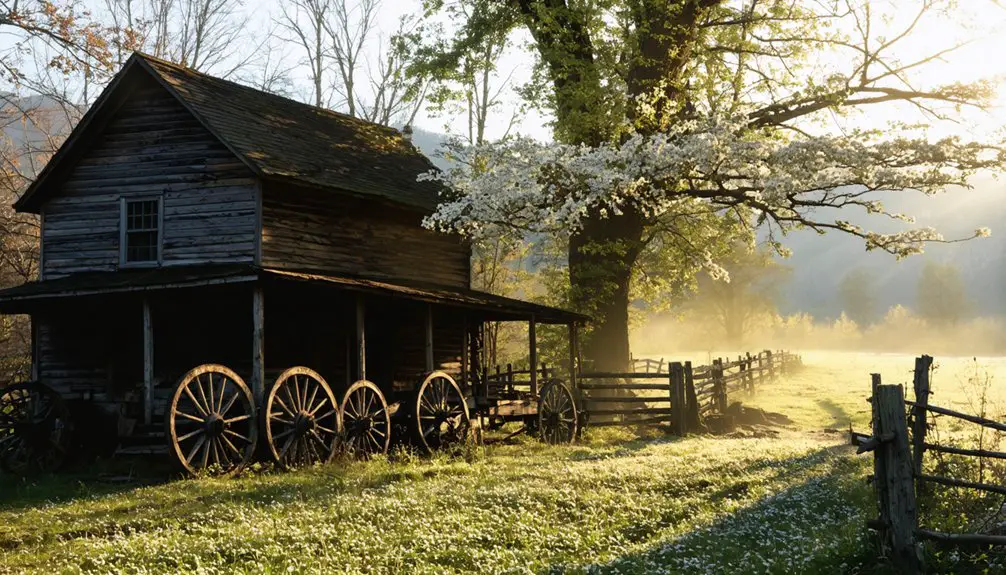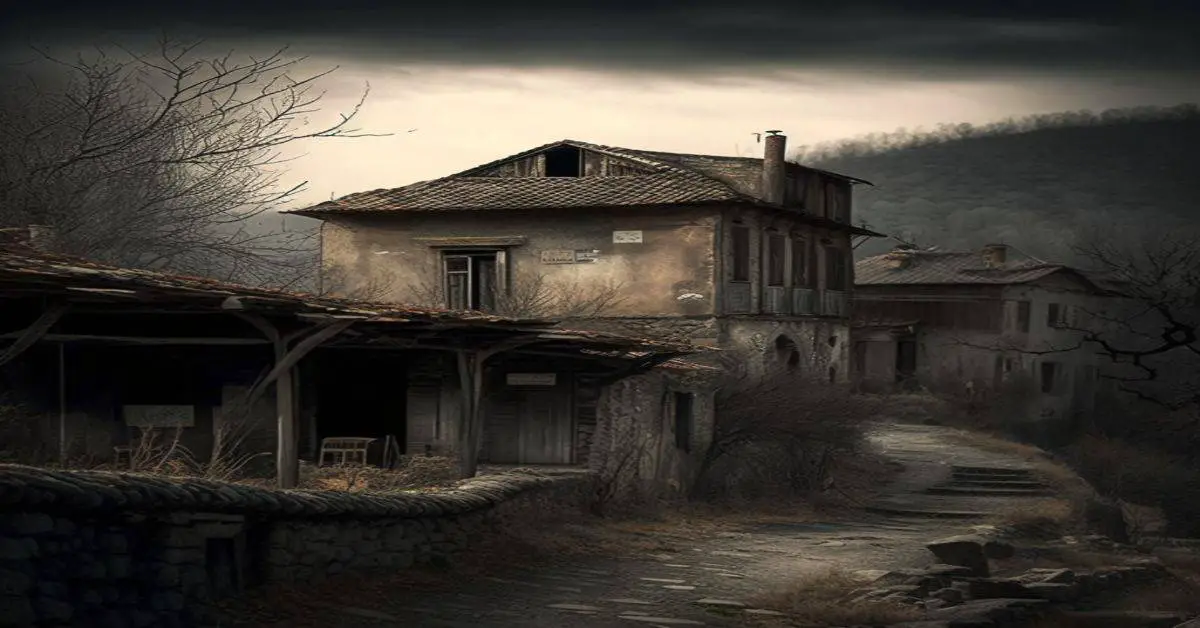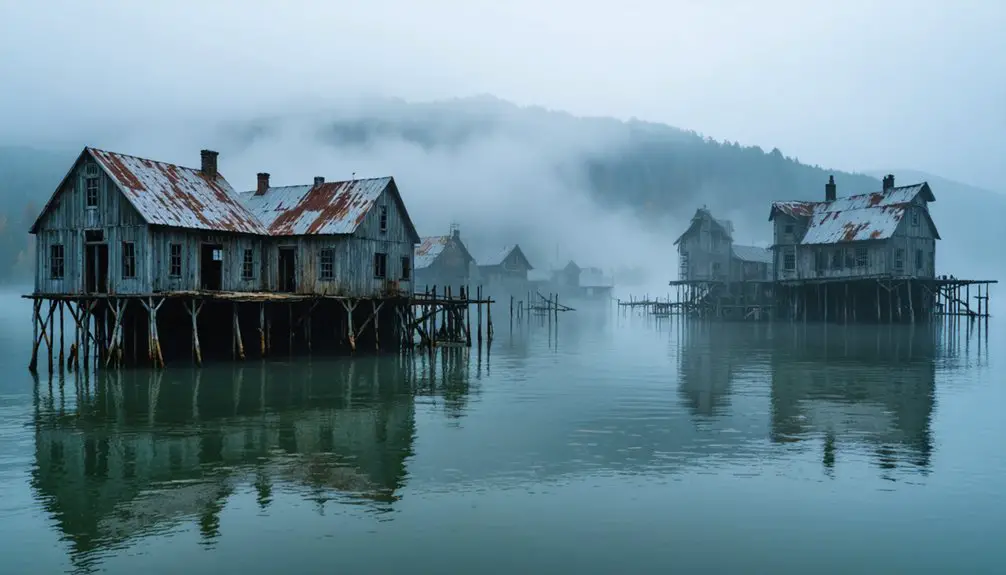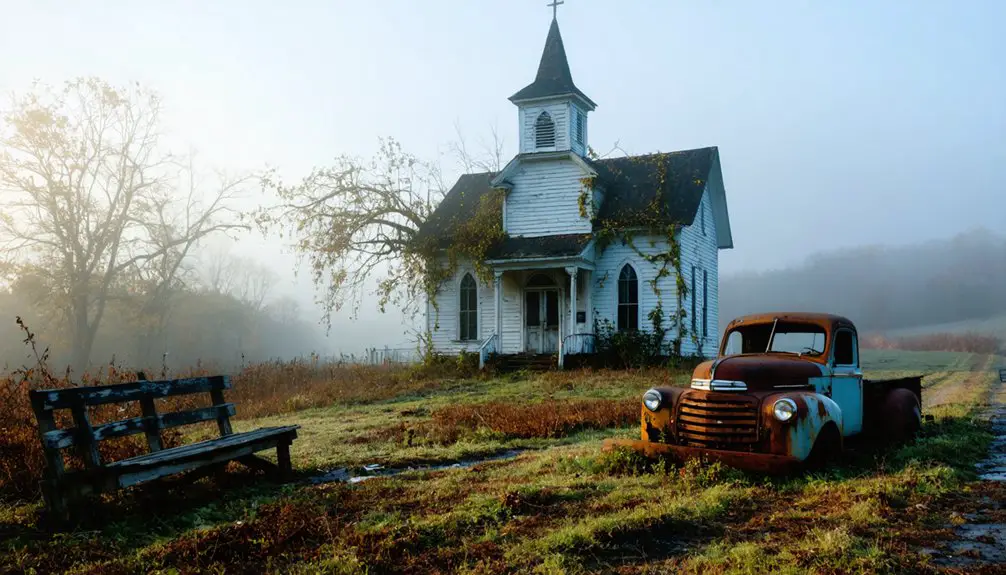You’ll discover one of America’s most haunted ghost towns nestled within the Great Smoky Mountains National Park at Cades Cove, Tennessee. This historic valley began as a Cherokee seasonal hunting ground called Tsiya’hi before becoming a thriving pioneer settlement in 1818. Today, you can explore preserved log cabins, churches, and mills while learning about the area’s rich heritage. As night falls, you might encounter the mysterious spirits and unexplained phenomena that draw ghost hunters to these sacred grounds.
Key Takeaways
- Cades Cove transformed from a Cherokee settlement to a thriving pioneer community after the 1819 Treaty of Calhoun opened land for settlement.
- The isolated valley became home to over 600 residents by 1850, featuring farms, churches, and essential community structures.
- Preserved historic buildings include log cabins, barns, churches, and mills that showcase early American frontier life.
- The creation of Great Smoky Mountains National Park in the 1920s led residents to leave their homes and farms.
- Today, Cades Cove stands as a well-preserved ghost town attracting millions of visitors to explore its historic structures and haunted tales.
Early Cherokee Settlements and Chief Kade’s Legacy
Before European settlers established permanent homes in Cades Cove, the Cherokee people maintained a seasonal hunting settlement called Tsiya’hi, meaning “Otter Place,” due to the abundance of otters in local streams.
Tsiya’hi served as a crucial outpost along the lower Cherokee trail system, connecting the Overhill towns to Great Tellico and facilitating trade routes since at least 1740. As part of Cherokee culture, these trails were essential for communication, hunting, and migration through the Smoky Mountains.
The settlement’s leader, Chief Kade, left such an indelible mark on the area that his name became permanently associated with the cove itself. European trader Peter Snider verified Chief Kade’s connection to the cove’s naming.
While a competing theory once suggested the cove was named after Cherokee Chief Abraham’s wife Kate, historical records confirm Chief Kade’s true legacy in the region’s naming. The Treaty of Calhoun in 1819 ultimately ended Cherokee claims to the area, leading to the abandonment of their seasonal settlement.
From Native Land to Pioneer Valley
Following Cherokee trading paths through the Smokies, John and Lucretia Oliver became Cades Cove’s first permanent European settlers in 1818, surviving their initial winter in an abandoned Cherokee shelter.
You’ll find that the Oliver’s arrival marked a pivotal shift from Tsiya’hi, the Cherokee “Otter Place,” to what would become a thriving pioneer community.
As more settlers followed the ancient trails into the valley throughout the 1820s-1850s, they transformed the native landscape into farmland, establishing homesteads that supported over 600 residents by 1850. Settlers had to be resourceful, growing and processing wheat as their crop before later transitioning to corn. These early pioneers built essential structures including smokehouses and mills to sustain their agricultural way of life.
Cherokee Paths and Settlements
The Cherokee people maintained two vital trail networks through the Great Smoky Mountains during the 18th century, creating essential pathways between North Carolina and Tennessee.
You’ll find one route through Indian Gap, connecting the Rutherford Indian Trace to the Great Indian Warpath, while a lower trail crossed through what’s now Cades Cove via Ekaneetlee Gap.
At Tsiya’hi settlement, meaning “Otter Place,” the Cherokee established a seasonal hunting camp by 1797. Rather than permanent settlements, this area served as hunting grounds only. This lower trail led to Great Tellico villages along the Little Tennessee River.
You can trace their influence through names like Abrams Creek, named for Chief Abraham, and Cades Cove itself, honoring Chief Kade.
Though the Treaty of Calhoun in 1819 ended Cherokee claims to these lands, their legacy lives on through the trails and place names you’ll encounter throughout the area.
Pioneer Families Take Root
As Cherokee influence waned after the 1819 Treaty of Calhoun, pioneer families began establishing permanent roots in Cades Cove’s fertile valley.
You’ll find that War of 1812 veteran John Oliver and his wife Lucretia led the way, tackling the dense forests with determination. The Gregorys, Parsons, and Shields families soon followed, forging strong community bonds through marriage and mutual support.
These settlers’ pioneer resilience shines through their back-breaking work – clearing wilderness, building log structures, and establishing farms with basic tools. Their days started with dawn farm chores, tending to cattle and crops before the heat of day set in. The long three-day journey to Maryville for supplies highlighted their remote mountain existence.
They’ve created a vibrant community complete with churches and schools, transforming Cherokee hunting grounds into productive farmland. The settlers’ intermarriage, particularly between the Oliver and Shields families, strengthened their social fabric and guaranteed their survival in this isolated but promising mountain valley.
Life in the Flourishing Mountain Community
If you’d visited Cades Cove during its heyday, you’d have found pioneering families tending to their daily tasks of farming, preserving food, and maintaining their log homesteads built from local timber.
The community’s social fabric was woven through regular church gatherings, barn raisings, and educational activities in one-room schoolhouses where children learned basic academics. The valley’s fertile limestone soil allowed families to maintain successful farms and grow abundant crops.
You’d have witnessed how the intermarriage of founding families like the Olivers and Shields strengthened community bonds, while shared events and mutual support helped residents overcome the challenges of mountain life.
Daily Pioneer Activities
Life in Cades Cove revolved around a demanding dawn-to-dusk schedule of agricultural pursuits and community engagement.
You’d start your day by milking cows and tending to livestock before heading to the fields where farming techniques centered on growing corn, wheat, oats, and rye. The primitive blacksmith shop was vital for crafting and repairing essential farming tools. The John P. Cable Grist Mill processed your grain, while specialized structures like cantilever barns and corn cribs supported your farming operations.
Your community roles extended beyond individual farms. You’d collaborate with neighbors to build and maintain shared structures, visit the local post office established in 1833, and transport goods to markets in Maryville and Knoxville.
In the evenings, you’d preserve food through canning and drying, attend church services, or gather with neighbors, strengthening the tight-knit mountain community.
Community Events and Gatherings
The vibrant social fabric of Cades Cove centered around three core institutions: churches, schools, and cooperative work gatherings. These shared rituals fostered deep community cohesion in the remote mountain settlement.
You’d find neighbors helping each other through every aspect of life, from harvesting crops to supporting families during times of loss. The church bells served as a crucial communication system, with specific ring patterns alerting residents to deaths and community needs.
- Churches hosted regular worship services and community decision-making meetings.
- Schools provided education while strengthening social bonds between families.
- Work parties brought neighbors together for farm labor and construction projects.
This interconnected way of life created a resilient community where mutual aid and social gatherings were fundamental to survival and cultural preservation in the isolated valley.
Mountain Family Homesteads
Pioneer families of Cades Cove built sturdy, self-sufficient homesteads that reflected their resourceful spirits and deep connection to the land.
You’d find these mountain agriculture settlements centered around log cabins crafted from hewn timbers, with mud or clay chinking to shield against harsh weather. Each homestead showcased the family’s resilience through its essential structures – smokehouses for preserving meat, corn cribs for grain storage, and barns for livestock and hay.
Families worked together to maintain their independence, with men clearing land and tending livestock while women managed households and gardens.
You’d see them rotating crops on steep terrain, preserving food through smoking and drying, and sharing labor with neighbors. Their success depended on adapting Old World skills to mountain life and learning from Cherokee wisdom about local resources.
The Birth of Great Smoky Mountains National Park
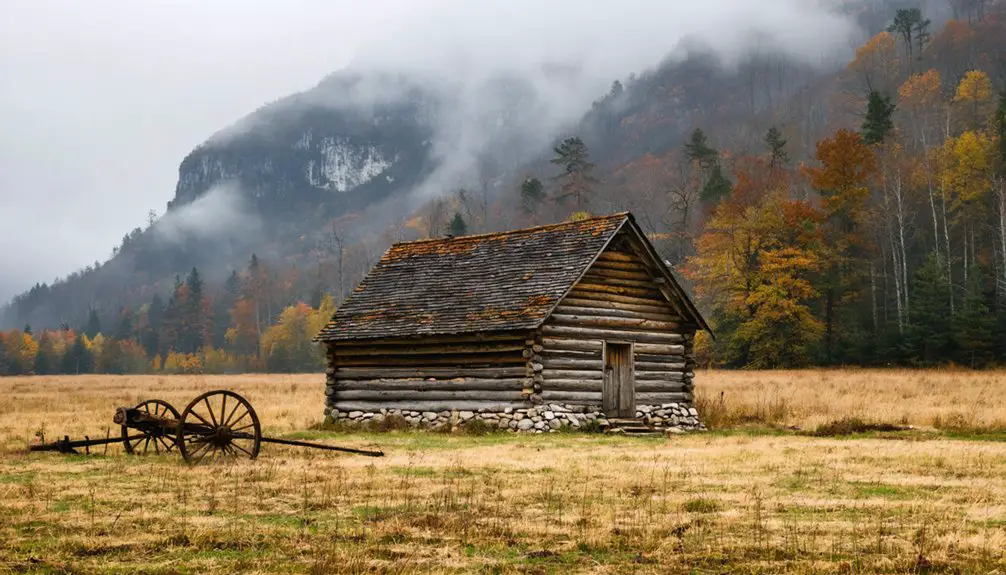
During the late 1890s, visionary conservationists proposed creating a protected wilderness area in the Smoky Mountains, though formal efforts wouldn’t begin until 1923.
Unlike western parks established on federal lands, creating this park required complex negotiations with hundreds of private landowners and timber companies for land preservation.
You’ll find these fascinating aspects about the park’s birth:
- Both Tennessee and North Carolina had to commit $2 million each by 1927
- The Rockefeller Foundation made the largest financial contribution
- Federal funding broke new ground, as it was the first national park to receive government money
The park’s development accelerated during the Great Depression when the Civilian Conservation Corps built trails, roads, and restored historic buildings.
Haunting Tales of the Cussing Cover
Deep within Cades Cove‘s isolated valley, where Cherokee tribes once thrived before European settlement, you’ll find the haunting legend of the Cussing Cover. This eerie tale centers around an enchanted lake and the mysterious death of a young man by a bear, blending local folklore with vengeful spirit themes.
You’ll discover that haunted legends persist throughout the cove, where mystical orbs of light dance around historic graveyards at twilight.
Former residents who signed life-leases to stay on their land after the national park’s creation add another layer to these supernatural stories. Many believe their spirits still guard their former homes, confused and unsettled by modern visitors.
The Cussing Cover remains one of the area’s most intriguing ghost stories, embodying the deep spiritual connection between the land and its past inhabitants.
Mysterious Encounters at Historic Buildings
Among the historic structures dotting Cades Cove’s landscape, the Primitive Baptist Church stands as a focal point for paranormal activity.
You’ll encounter some of the most compelling ghostly sightings here, where visitors report a mysterious woman’s apparition emerging from the building’s walls after dark.
Throughout Cades Cove’s historic buildings, you’ll find evidence of supernatural presence:
- The Baptist Church echoes with unexplained noises, including phantom footsteps and disembodied voices
- Preserved homes and cabins experience sudden temperature drops and shadowy figures
- Barns and outbuildings harbor whispers and sounds of invisible animals
Whether you’re exploring the church grounds, historic homesteads, or agricultural structures, you’ll discover that each building holds its own eerie tales, making Cades Cove a reflection of the supernatural echoes of its past residents.
Paranormal Activity in Sacred Grounds
Sacred grounds throughout Cades Cove pulse with paranormal energy, where the spiritual legacy of Cherokee tribes and early Appalachian settlers converges.
You’ll find the most intense activity at the Primitive Baptist Church, where unexplained footsteps and voices echo through its hallowed walls. The church’s spiritual significance draws both the living and the dead, creating a unique intersection of natural and supernatural forces.
At twilight, luminous orbs dance through ancient graveyards, while shadow figures drift near weathered homesteads.
These manifestations intensify during storms, particularly around sites steeped in ghostly legends like the “Cussing Cover” tale and the haunted bride story.
The sacred grounds hold centuries of Cherokee folklore and settler experiences, creating layers of paranormal activity that continue to captivate visitors seeking connections to the otherworldly.
Preserving Appalachian Pioneer Heritage
When John Oliver and Lurena Frazier first settled Cades Cove in the early 1800s, they established a legacy that’s meticulously preserved today through original structures and artifacts.
You’ll find their pioneering spirit alive in the carefully maintained buildings and tools that showcase authentic 19th-century Appalachian life.
The National Park Service’s heritage preservation efforts guarantee you can experience:
- Hand-hewn log cabins, churches, and mills that demonstrate traditional construction methods
- Original farming implements and household items that tell stories of self-sufficient mountain living
- Living history demonstrations where you’ll learn pioneer skills firsthand
Through cultural education programs and oral histories from pioneer descendants, you’ll discover how these early settlers transformed this former Cherokee territory into a thriving community of 600 residents by 1850.
Modern Tourism and Ghost Hunting Adventures
Today’s Cades Cove draws over 12 million annual visitors who flock to this historical treasure within the Great Smoky Mountains National Park.
You’ll discover a vibrant mix of daytime sightseeing and evening ghost tours along the 11-mile loop, where wildlife encounters with bears, deer, and turkey enhance your adventure.
For paranormal experiences, you can join guided nighttime investigations of the cove’s pioneer structures. These tours often employ modern ghost hunting equipment while preserving the site’s historical integrity.
During peak seasons, especially fall foliage weeks, you’ll want to plan carefully as visitor numbers have surged 32% in the last decade.
Consider visiting during vehicle-free days in summer or booking an off-peak ghost tour to avoid crowds and fully immerse yourself in Cades Cove’s mysterious atmosphere.
Frequently Asked Questions
What Is the Best Time of Year to Photograph Ghostly Orbs?
With 75% of orb sightings occurring in autumn, you’ll capture the best ghostly phenomena during October’s fall foliage. Plan your nighttime photography sessions during twilight hours when atmospheric conditions enhance visibility.
Are There Any Documented Deaths From Supernatural Encounters in Cades Cove?
While ghostly legends and spectral sightings abound, you won’t find any officially documented deaths from supernatural encounters. Claims of paranormal fatalities remain firmly in the domain of folklore and storytelling.
Do Rangers Report Paranormal Experiences During Their Night Patrols?
You’ll find rangers reporting unexplained voices, mysterious figures, and sudden temperature drops during night patrols, though they rarely document these encounters officially, preferring to share their ghostly sightings informally among colleagues.
Which Historic Buildings Have the Highest Number of Reported Hauntings?
You’ll find the most haunted history at the Primitive Baptist Church, where ghost stories abound, followed by The Cussing Cover’s frequent paranormal reports and the numerous sightings throughout Elkmont’s abandoned structures.
Can Visitors Bring Paranormal Investigation Equipment Into the Historic Structures?
Like moths drawn to flame, you’re bound by strict paranormal etiquette. Investigation guidelines prohibit bringing equipment inside historic structures – you’ll need special permits and can’t enter without ranger supervision.
References
- https://gatlinburghaunts.com/haunted-cades-cove-the-cussing-cover/
- https://visitcadescove.com/cades-cove-blog/cades-cove-ghost-stories-legends-and-lore-of-the-smokies/
- https://smokymountainnationalpark.com/blog/smoky-mountain-ghost-stories/
- https://en.wikipedia.org/wiki/Cades_Cove
- https://www.youtube.com/watch?v=ct6nipddxHA
- https://www.hearthsidecabinrentals.com/blog/smoky-mountains/fascinating-history-of-cades-cove/
- https://experiencecadescove.com/blog/guide-to-cades-cove-history/
- https://mysmokymountainguide.com/gsmnp/brief-history-cades-cove/
- https://npshistory.com/publications/grsm/cades-cove-1965.pdf
- https://www.smokiesadventure.com/smokymountains/cadescove/cades_cove_history.htm
